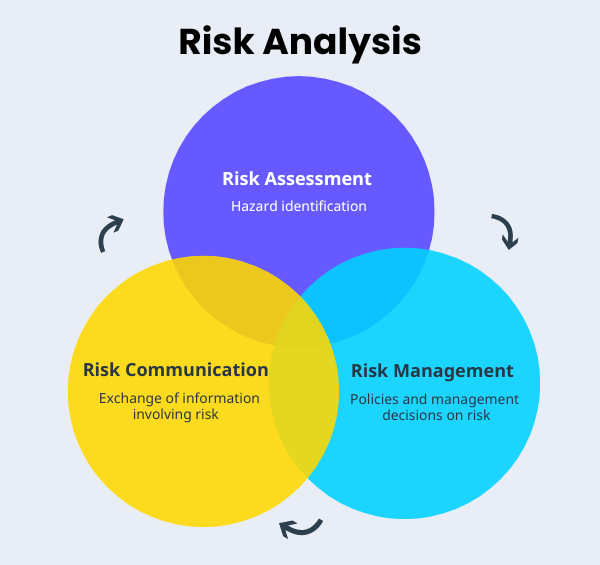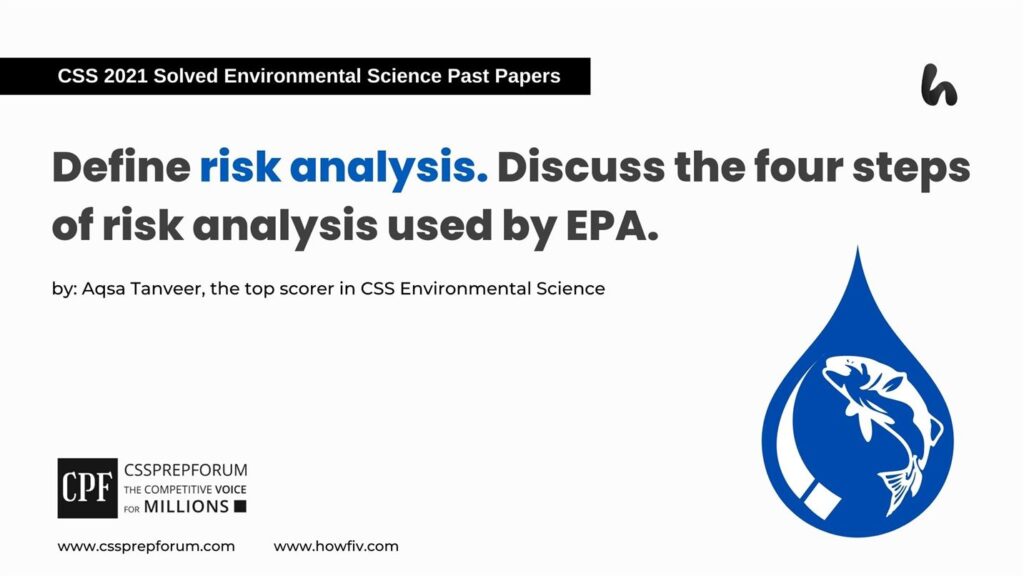CSS 21 Solved Environmental Science Past Paper | Define risk analysis. Discuss the four steps of risk analysis used by EPA.
Aqsa Tanveer, the highest scorer in the CSS Environmental Science paper, attempts the following question. The answer is written on the same pattern, taught by Sir to his students, scoring the highest marks in compulsory subjects for years. This solved past paper question is uploaded to help aspirants understand how to crack a topic or question, how to write relevantly, what coherence is, and how to include and connect ideas, opinions, and suggestions to score the maximum.

Question Breakdown
In this question, the examiner enquires risk analysis and steps used by EPA for risk analysis. An inclusive and appropriate outline is mandatory to interpret the question better. You have to begin with an introduction and a glance at the concept of risk analysis. Furthermore, purpose and importance of risk analysis must be described to address the first part of the question. Then, it would be best if you illustrate EPA steps for risk analysis in most effective manner. As a way forward, you have to present EPA’s risk analysis principles. For value addition, diagrams and flow charts can play an influential role. A satisfactory conclusion must be given at the end to summarize the whole question.
Outline
1- Introduction
2- A Glance at the concept of Risk Analysis
3- Purpose of Risk analysis
4- Importance of Risk Analysis
5- Types of risk analysis
- ✓Qualitative analysis
- ✓Quantitative analysis
6- EPA’s Steps of risk analysis
- ✓Hazard identification
- ✓Dose-response assessment
- ✓Exposure assessment
- ✓Risk characterization
7- EPA’s risk analysis principles
- ✓Transparency
- ✓Clarity
- ✓Consistency
- ✓Reasonableness
8-Conclusion

Answer to the Question
Introduction
Risk analysis is identifying and analyzing critical issues that negatively impact vital projects. This process is done to keep various organizations to mitigate respective risks. The domain of risk analysis involves adverse events caused by either natural processes such as hurricanes, earthquakes, floods and adverse events caused by anthropogenic activities. Therefore, risk analysis includes the identification of the potential harm of these damaging events. Risk assessment helps different organizations and governments to analyze the possibility of the adverse impact of the investment. Assessing risk is significant in mitigating these risks and is essential for determining the worth of a specific project. Risk analysis inculcates various approaches that can be used to assess the risk and tradeoff rewards for investment activity. Risk analysis starts with the identification of the potential harms of a particular project. The cost-benefit analysis must be weighed against a probability metric that measures the likelihood of an adverse event. Hence, risk analysis attempts to estimate the negative impacts of a project. Risk analysis allows professionals in the identification and mitigation of risks. EPA considers that risk is the probability of harmful effects on human health and ecological systems from exposure to an environmental stressor. An environmental stressor is any physical, chemical and biological entity that can result in an adverse response. Therefore, these stressors may adversely affect natural resources, including plants, animals and the entire ecosystem. The focus of risk analysis and the format of its results vary based on the types of risk. It inculcates the evaluation of stressor-response relationships. Moreover, the risk analysis calculates ecological responses to stressors. Risk assessment measures the exposure by determining which receptor, either plants or animals likely to be exposed and the extent of exposure. It is rightly said that:
“Don’t be fearful of risks. Understand them, and manage and minimize them to an acceptable level.”
Purpose of Risk analysis:
The purpose of Risk assessment revolves around a process of evaluating qualitative and quantitative information about health hazards. Furthermore, evaluation of the substance that is the source of risk. It revolves around three phases such as, risk assessment, risk management and risk communication.
Importance risk analysis:
Risk analysis is used by governmental and non-governmental organizations to:
- Reduce the harmful effects of adverse events.
- Evaluate whether it balance the potential risks of a project.
- Identify the negative impacts and prepare for changes in the respective environment.

Types of risk analysis
There are two basic approaches to risk analysis, such as qualitative and quantitative risk analysis:
- ✓Qualitative risk analysis:
It involves assessing the likelihood of risk based on subjective qualities. On a qualitative basis impact of risks is often categorized into three levels: low, medium or high. A qualitative risk analysis gives results based on the perception of the risk and its consequences.
✓Quantitative risk analysis:
On the other hand, quantitative risk analysis assigns a specific amount to adverse events by assessing potential costs in a given time duration. Quantitative risk analysis determines a project’s overall risk and generally is conducted after a qualitative risk analysis. The quantitative risk analysis examines the probability of each risk and its consequences numerically.
EPA’s Steps of risk analysis
Environmental Protection Agency (EPA) conducts risk assessment through the following steps:
- Hazard identification,
- Dose-response assessment
- Exposure assessment
- Risk characterization

✓Hazard identification
This process examines the harmful effects of stressors on humans and the ecosystem. Hazard identification involves analyzing the mode of action and evaluating the weight of evidence. Therefore, risk identification is making the list of potential risks. These are internal hazards that arise within an organization; most dangers are external and occur from stressors outside. Significant risks within an organization are determined through SWOT analysis. SWOT analyses are often broader than risk analyses, but a risk analysis is more specific while addressing a particular problem more specifically.
✓Dose-response assessment
This process examines the relationship between the degree of exposure and toxic effects. Measured response increases with an increase in the stressor’s dose.
✓Exposure assessment
This process examines the frequency, duration, and levels of exposure to the stressors. Therefore, this process quantifies the range of exposure. Moreover, with available data, it analyzes the results. The exposure assessment provides the course a stressor takes from the source to the receptor, such as waste from land into water and how exposure occurs. The exposure assessment determines the contact between the stressor and the receptor.
✓Risk characterization
It describes the stressor’s risk by integrating all processes and provides a foundation for policymaking. Risk assessment is based on statistical models and data on biochemical and physiological factors generated by in-vitro and in-vivo experiments. Hence, it is time to put a plan into action. Moreover, in risk acceptance strategies, sometimes an organization decides not to change course and deal with risk after it occurs. In contrast, often, management decides to reduce or eliminate the presented risk.
There are the following objectives of the risk characterization phase:
- Determine the risk
- Describe the degree of confidence in the risk estimates
- Point out the uncertainties
- Put forward the evidence of exposure, stressor-response and risk estimates
- Interpretation of the adversity of ecological effects
EPA’s risk analysis principles
Based on EPA’s risk characterization policy, the risk characterizations should be conducted in a manner consistent with the following principles:
- ✓Transparency
The risk characterization should be done to disclose the risk assessment methods explicitly through assumptions, logic, rationale and integrated strength of each step in the assessment process.
“Regulatory compliance is critical to managing risk.
- ✓Clarity
Risk assessment outcomes should be comprehensive for readers during the whole risk assessment process. These documents of risk analysis should be concise without any jargon. These documents should use complete tables, graphs, flowcharts and equations as required.
- ✓Consistency
The risk assessment should be performed and presented consistent with EPA policy and integrated with other risk characterizations of similar scope. It should be prepared across programs within the EPA’s range.
- ✓Reasonableness
The risk assessment should be based on sound judgment. It should use methods and assumptions consistent with the current state of technology. Moreover, it should be presented in a complete, concise, balanced and informative.
“Everything in life has some risk. What you have to actually learn to do is how to navigate it. ”
Conclusion:
To sum up, adverse ecological effects of stressors are undesirable as these stressors alter the structure, function and services provided by the risk assessment. Therefore, to achieve a proper risk characterization, the EPA’s principles must be applied in all of the assessment steps. Moreover, use the results concluded through analysis to estimate the risk posed to the ecosystem and humans. Risk management is becoming the most challenging aspect. Furthermore, applying a simple and streamlined risk management process can pave the way for predicting uncertainties in the projects and minimize the occurrence and adverse impact of the stressors. Risk management provides help in avoiding crisis situations and provides lessons to learn from previous mistakes. Therefore, this paves the way for the successful completion of projects and reduces the consequences of those risks.
‘‘An investment business has certain risks, and your job as an investor is not to eliminate all risks but to manage and minimize them.’’
CSS Solved Past Papers’ Essays
Looking for the last ten years of CSS and PMS Solved Essays and want to know how Sir Kazim’s students write and score the highest marks in the essays’ papers? Then, click on the CSS Solved Essays to start reading them.
CSS Solved Essays

CSS Solved General Science & Ability Past Papers
Want to read the last ten years’ General Science & Ability Solved Past Papers to learn how to attempt them and to score high? Let’s click on the link below to read them all freely. All past papers have been solved by Miss Iqra Ali & Dr Nishat Baloch, Pakistan’s top CSS GSA coach having the highest score of their students.
General Science & Ability Solved Past Papers
CSS Solved Pakistan Affairs Past Papers
Want to read CSS Pakistan Affairs Solved Past Papers and learn how to attempt them to score high? Let’s click on the link below to read them all freely. All past papers’ questions have been attempted by Sir Kazim’s students, who scored the highest in the subject.
CSS Solved Pakistan Affairs
CSS Solved International Relations’ Past Papers
Have you opted for International Relations in the CSS examination and want to score above 150? Then, click on the CSS Solved International Relations’ Past Papers by Miss Abeera Fatima, the top IR scorer and the best IR coach in Pakistan.
CSS Solved International Relations Past Papers
Articles Might Interest You!
The following are some of the most important articles for CSS and PMS aspirants. Click on any to start reading.












